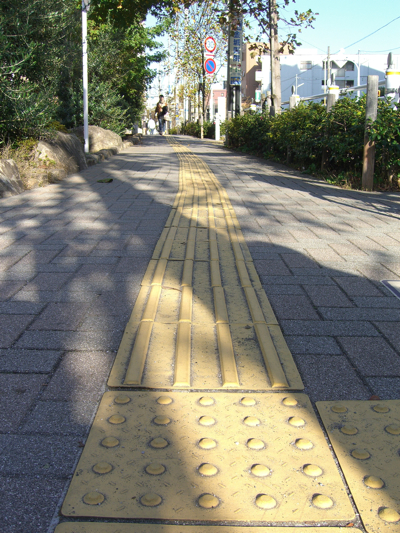As many of you were able to correctly guess, this:
Is an extreme close-up of this:
The official name is 視覚障害者誘導用ブロック (しかくしょうがいしゃゆうどうようぶろっく). They are also known as 点字ブロック (てんじぶろっく, literally “Braille Blocks”), but Wikipedia notes that they do not actually use Braille as the name suggests.
They do, however, have meaning. This website does a great job of illustrating how the blocks with grooved lines (in Japanese, 誘導ブロック or 線状ブロック) mean walk forward but the dotted blocks (警告ブロック or 点状ブロック) signify a stop or a turn – somewhere that requires caution like a train platform or a big street.
It’s always amazes me how ubiquitous these are. They have been installed just about everywhere in Japan in an attempt to create the most バリアフリー country ever. Oh, and if you were wondering, バリアフリー ≠ “barrier-free” (or at least I don’t think it should in translation unless you are talking specifically about Japanese efforts to promote accessibility). バリアフリー = “handicapped accessible” or whatever the appropriate PC term is in English.
Julian, Doug, Jerry, Thomas, and William all get Google Wave invites, and Thomas gets the beer. Nice work, guys! It should take a few days for the invites to go through, but I’ve put your names in. Julian also let me know that the term 点字タイル is used by the Nankai Railway. Very cool – I like the alliteration, and “tile” is probably more accurate than “block.”



Facebook friend Jerry posted a really interesting comment on my feed: One of my roommates my last year at university was a blind exchange student from Japan. I thought it was interesting that (apparently) the canes used by the visually impaired in the US are longer than the ones used in Japan. During his orientation at the university, they gave him a new cane that was notably longer — like 20 cm or so. He said it was much easier to use, and compared it to having improved “vision”.
A woman I saw on the train yesterday had a cane that came up to about her waist. I wonder if there is a reason for shorter canes in Japan?
And my response: That’s a really interesting story! I can only imagine that it would be like suddenly being able to see that much further in all directions. I wonder if it’s because cities like Tokyo are so crowded that it forces people to use shorter canes.
That was so obvious I thought I couldn’t be right!